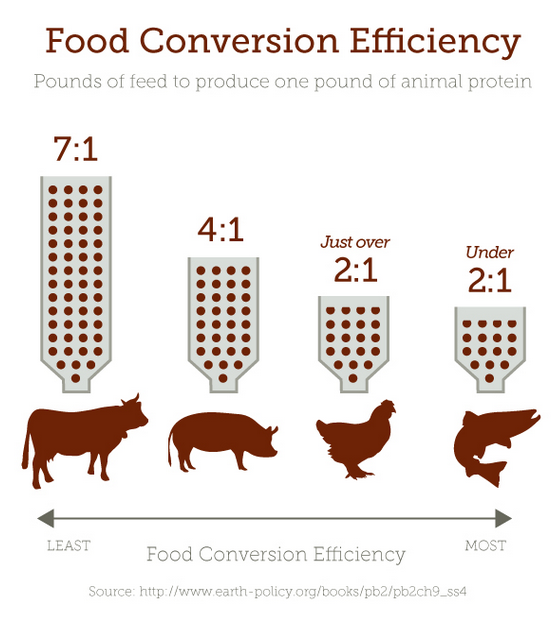Meat and Animal Products
Exploring the practices behind animal agriculture.
As with plants, meat and animal products are produced as efficiently as possible. This is reflected in how they are raised and processed. Here, we’ll get into it.
Click on an icon to jump to a section:
CAFO
CAFOs: the Pros
CAFOs are the most efficient way to produce meat and animal products.
What is a CAFO?
C = Concentrated
A = Animal
F = Feeding
O = Operation
Let’s break that down a little more—that’s a place where a lot of animals are put into a small space to eat as much as they can as quickly as they can.
A CAFO uses the least amount of space and time to get an animal to a goal weight for sale as meat.
So, CAFOs help farmers by letting them produce more livestock on less land, in turn saving them money.
But, CAFOs have drawbacks, too.
CAFOs: the Cons
Take the quiz to test your knowledge of meat production’s drawbacks! Then, keep scrolling to learn how these drawbacks overlap with CAFOs.
For starters, cows and pigs eat a lot!
Most farmland in the United States is used to grow food for livestock.
Chickens don’t take nearly as much feed as pigs and cows, but they still use more caloric energy from grains than they create when we eat chicken.
For chickens and pigs, a lot of the environmental impact comes from growing their food.
As we learned earlier, there are lots of issues with growing corn and soy in a monoculture system. Using even more of these crops to feed livestock only amplifies those issues. This chart shows the greenhouse gas emissions associated with all these different foods.
Remember, as we mentioned in our section on monoculture, the issues caused by climate change are felt disproportionately by communities of color because of the legacy of systemic policies and structures like residential segregation.
CAFO living conditions are also often inhumane. Animals in CAFOs outdoors often have no shade to rest in, leading to overheating and stress.
Overly crowded animals can develop aggressive tendencies like pecking and scratching. To prevent them from hurting each other, sometimes farmers will “de-beak” chickens, or cut their beaks short. Castration, de-beaking, and tail docking, all of which occur frequently in CAFOs, are all frequently carried out without any pain medication.
Sometimes, animals kept in a large-scale operation like this are separated from their young, either temporarily or permanently.
All of these practices prevent animals from practicing their natural behaviors, create stress, and at times can put animals in physical pain. These practices apply to red meat as well as white meat and poultry—they aren’t limited to just some meat practices.
In such close quarters, animals are also more likely to get diseases from each other. A lot of farmers use preventative antibiotics. But overusing antibiotics makes them less effective! It leads to antibiotic resistance, a similar phenomenon to what we talked about with pesticide resistance.
When just a few bacteria survive antibiotics but all others are killed, the few that live pass on their ability to survive to their offspring. The more antibiotics we use, the more bacteria are able to survive them. So, we could lose the tool of antibiotics to fight infection.
CAFOs can also cause pollution. Since animals in CAFOs are fed corn and soy instead of grazing on pasture, CAFOs don’t usually have any grass or plants growing near the livestock.
Without ground cover, the soil starts to wash away. That means that when the livestock poop, it can sometimes be washed directly into nearby water sources. This is similar to the issues with runoff we talked about with pesticides and fertilizers.
Runoff pollutes waterways, which hurts aquatic ecosystems and drinking water.
Our cheapest eggs and milk also come from chickens and cows who live on CAFOs. That means the same environmental and animal welfare problems associated with meat production are also abundant in the production of eggs and milk.
Slaughter
The cheapest way to slaughter livestock is to send them off the farm.
It makes sense that that would be the most common way to slaughter. But transporting animals to a slaughterhouse is highly stressful. Just like with meat from CAFOs, stress affects flavor, not just animal welfare.
On top of that, slaughterhouses are hazardous workplaces. Labor issues like dangerous chemicals, heavy machinery, and poor worker protection are abundant, just as they are in vegetable production.
You can read more about all of this in great detail in our 101 resource collection!
Producing meat efficiently is great for profits, but it means that ethics, humane treatment, and sustainability are often left behind. As a result, it can be tough to find meat and animal products that meet your values. Meat produced for efficiency’s sake also doesn’t bode well for flavor. When livestock are stressed out, it changes the flavor of the meat. Transporting cows to slaughter in particular can lead to lower quality meat.
Want to learn more?
Select a topic below to read our animal 101 articles:
Ready to move on?





















